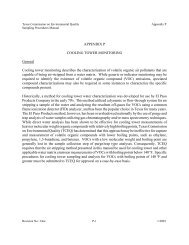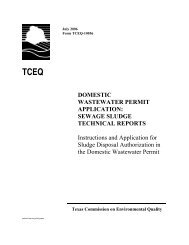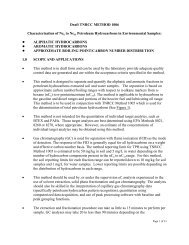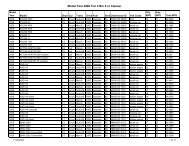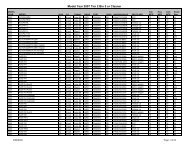Vinyl Chloride - Texas Commission on Environmental Quality
Vinyl Chloride - Texas Commission on Environmental Quality
Vinyl Chloride - Texas Commission on Environmental Quality
Create successful ePaper yourself
Turn your PDF publications into a flip-book with our unique Google optimized e-Paper software.
<str<strong>on</strong>g>Vinyl</str<strong>on</strong>g> chloride<br />
Page 14<br />
4.1.2 MOA Analysis and Dose Metric<br />
Evidence is str<strong>on</strong>g that the liver toxicity and carcinogenicity of VC are related to the producti<strong>on</strong> of<br />
reactive metabolic intermediates. Up<strong>on</strong> absorpti<strong>on</strong> and distributi<strong>on</strong>, VC is metabolized by the cytochrome<br />
P450 oxidati<strong>on</strong> system in the liver (Ivanetich et al. 1977, Sabadie et al. 1980, Salm<strong>on</strong> 1976). VC is<br />
primarily metabolized to chloroethylene oxide (CEO), which is a highly reactive, short-lived epoxide<br />
intermediate. Some CEO sp<strong>on</strong>taneously rearranges to form chloroacetaldehyde (CAA). Metabolites of<br />
VC are detoxified by a reacti<strong>on</strong> with glutathi<strong>on</strong>e (GSH) catalyzed by glutathi<strong>on</strong>e-S-transferase. The GSH<br />
c<strong>on</strong>jugates may then undergo hydrolysis to be excreted in urine. The metabolites may bind to<br />
macromolecules in the body; CEO is thought to bind primarily to deoxyrib<strong>on</strong>ucleic acid (DNA) and<br />
rib<strong>on</strong>ucleic acid (RNA) and CAA is thought to bind primarily with protein. The mechanism for liver<br />
toxicity is thought to be related to the producti<strong>on</strong> of reactive metabolites that covalently bind to liver<br />
proteins. Animal studies indicate that metabolism of VC is a dose-dependent saturable process (ATSDR<br />
2006). Saturati<strong>on</strong> is thought to occur in humans at air c<strong>on</strong>centrati<strong>on</strong>s above 250 ppm (Clewell et al.<br />
2001). See Figure 1 for a descripti<strong>on</strong> of VC metabolism.<br />
<str<strong>on</strong>g>Vinyl</str<strong>on</strong>g> <str<strong>on</strong>g>Chloride</str<strong>on</strong>g><br />
P450<br />
Adapted from USEPA (2000)<br />
H 2 0<br />
DNA Adducts<br />
Chloroethylene<br />
oxide<br />
(CEO)<br />
CO 2<br />
Epoxide<br />
Hydrolase<br />
GSH<br />
Figure 1. Metabolism of <str<strong>on</strong>g>Vinyl</str<strong>on</strong>g> <str<strong>on</strong>g>Chloride</str<strong>on</strong>g><br />
Tissue Adducts<br />
Chloroacetaldehyde<br />
(CAA)<br />
GSH<br />
Glutathi<strong>on</strong>e<br />
C<strong>on</strong>jugates<br />
The most appropriate pharmacokinetic dose metric for a reactive metabolite is the total amount of the<br />
metabolite generated divided by the volume of tissue in which it is produced (Anders<strong>on</strong> et al. 1987 as<br />
reported in USEPA 2000); however, <strong>on</strong>ly data <strong>on</strong> exposure c<strong>on</strong>centrati<strong>on</strong> of the parent chemical are<br />
available from the key study. Since data <strong>on</strong> other more specific dose metrics (metabolite c<strong>on</strong>centrati<strong>on</strong>s




